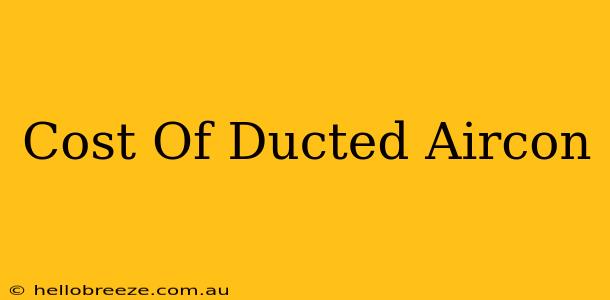Thinking about installing ducted air conditioning? It's a significant investment, so understanding the cost is crucial. This guide breaks down the factors influencing the price of ducted air conditioning, helping you budget effectively.
Factors Affecting the Cost of Ducted Air Conditioning
Several key factors determine the final cost of your ducted air conditioning system. These include:
1. System Size and Capacity
The size of your home directly impacts the cost. Larger homes require more powerful systems with more extensive ductwork, leading to higher expenses. The capacity (measured in kW or BTUs) also plays a significant role; a higher capacity system capable of cooling a larger area will naturally cost more. Accurate assessment of your home's cooling needs is crucial for avoiding overspending or underpowering your system.
2. Type of System
Different types of ducted air conditioning systems exist, each with varying price points. These include:
- Reverse-cycle systems: These offer both heating and cooling, usually costing more upfront but saving money in the long run.
- Single-phase vs. three-phase systems: Three-phase systems are generally more powerful and better suited for larger homes, resulting in a higher initial cost.
Choosing the right system type is vital for efficiency and long-term cost savings.
3. Brand and Model
Brands vary significantly in price and features. While premium brands often offer advanced technology and longer warranties, they come with a higher price tag. Researching different brands and models to find the best balance between quality and cost is recommended. Consider factors beyond initial cost, such as energy efficiency ratings and warranty periods.
4. Installation Complexity
The complexity of installation greatly influences the overall cost. Factors contributing to complexity include:
- Home size and layout: Homes with unusual layouts or difficult-to-access areas can increase labor costs.
- Existing infrastructure: The presence of pre-existing ductwork or obstructions can affect installation time and cost.
- Location of the outdoor unit: The location of the outdoor unit can impact installation difficulty and expenses.
Planning ahead and considering potential installation challenges will allow you to get a more accurate estimate.
5. Location and Labor Costs
Geographic location significantly affects labor costs. Installation costs in metropolitan areas are generally higher compared to regional areas. The installer's experience and reputation also influence pricing; experienced and reputable installers may charge more but often provide better quality work and warranties.
6. Additional Features
Optional features such as smart home integration, zoning systems (allowing for independent temperature control in different zones), and advanced filtration can increase the total cost. However, these upgrades may offer significant benefits in terms of comfort, energy efficiency, and convenience. Carefully weigh the benefits of additional features against their cost.
Getting Accurate Quotes
To obtain accurate quotes, contact several reputable air conditioning installers in your area. Provide them with detailed information about your home, including size, layout, and cooling needs. Ensure that quotes include all costs, such as equipment, installation, and any applicable permits. Compare quotes carefully, considering not only price but also the installer's reputation, warranty offered, and the overall system's energy efficiency.
Budgeting for Ducted Air Conditioning
The cost of ducted air conditioning can vary substantially. While a basic system for a smaller home might cost less than $5,000, larger homes with complex installations and premium systems could easily exceed $15,000 or more. Careful planning and obtaining multiple quotes are essential for managing costs effectively. Exploring financing options may also be beneficial.
By understanding the factors that influence the cost of ducted air conditioning, you can make informed decisions and ensure you get the best system for your needs and budget. Remember that investing in a high-quality, energy-efficient system offers significant long-term savings on energy bills.

